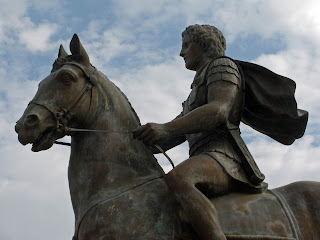Gold, like bronze and silver, is a commodity that over the centuries was melted down time and again by whoever possessed the precious mineral and wanted to transform it for his own use. This is why large bronze statues are so rare and the examples we have in our museums these days generally come from underwater archaeology where they were hidden from view. Large gold objects are even more rare.
This brings me to this solid bust of Emperor Septimius Severus made end 2nd/beginning 3rd century AD. It was found in 1965 among the ruins of ancient Plotinopolis, a city founded in the early 2nd century by Emperor Trajan who named it after his wife Pompeia Plotina. Plotinopolis was actually built on top of the Thracian and Hellenistic town of Didymoteicho
The city was ideally located on the banks of the Bulgarian Maritsa River that becomes the Evros River when it enters eastern Greece
Today Plotinopolis is called Kale after the Turkish word for castle as it lies south of Edirne , Turkey 20 km north of Soufli in the Thracian Province of Greece.
The magnificent gold bust of Septimius Severus can be admired at the Archaeological Museum








